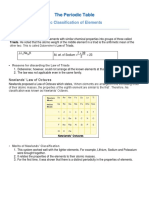0% found this document useful (0 votes)
50 views37 pagesClass10 Chapter2
The document discusses the historical development of the periodic table, highlighting key contributions from scientists such as Dobereiner, Newlands, and Mendeleev. It explains the need for classification of elements, the limitations of early classification methods, and the transition to the modern periodic law based on atomic numbers. The modern periodic table addresses many shortcomings of Mendeleev's table while still leaving some ambiguities, such as the position of hydrogen.
Uploaded by
Pratik GudsurkarCopyright
© © All Rights Reserved
We take content rights seriously. If you suspect this is your content, claim it here.
Available Formats
Download as PDF, TXT or read online on Scribd
0% found this document useful (0 votes)
50 views37 pagesClass10 Chapter2
The document discusses the historical development of the periodic table, highlighting key contributions from scientists such as Dobereiner, Newlands, and Mendeleev. It explains the need for classification of elements, the limitations of early classification methods, and the transition to the modern periodic law based on atomic numbers. The modern periodic table addresses many shortcomings of Mendeleev's table while still leaving some ambiguities, such as the position of hydrogen.
Uploaded by
Pratik GudsurkarCopyright
© © All Rights Reserved
We take content rights seriously. If you suspect this is your content, claim it here.
Available Formats
Download as PDF, TXT or read online on Scribd
/ 37


















































































